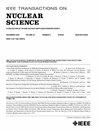一种精确的脉冲到达时间估计方法:以高能粒子探测器为例
IF 1.9
3区 工程技术
Q3 ENGINEERING, ELECTRICAL & ELECTRONIC
引用次数: 0
摘要
现代电子技术的进步使信号采样具有更高的分辨率,促进了确定探测器脉冲到达时间的新技术的应用。本文介绍了一种精确估计脉冲到达时间的方法。该方法不受偏移、慢速背景变化和脉冲堆积效应的影响,只需要一个参数。利用合成脉冲和从粒子物理探测器收集的实验数据,通过模拟和系统比较传统方法进行了验证。结果表明,与常用的等分数判别法和前沿判别法相比,该方法具有更高的准确度和精密度。此外,该方法适用于硬件实现,可以应用于各种实验环境中的各种脉冲类型,使其成为各种应用中到达时间估计的通用工具。本文章由计算机程序翻译,如有差异,请以英文原文为准。
A Method for Accurate and Precise Pulse Arrival Time Estimation: A Case Study on High-Energy Particle Detectors
Advancements in modern electronics have enabled the sampling of signals with higher resolution, facilitating the application of new techniques for the determination of pulse arrival times at detectors. In this article, we introduce a method for accurate and precise pulse arrival time estimation. This method is immune to offset and slow background variations and pulse pile-up effects, requiring a single parameter. The validation is performed through simulations and systematic comparisons with traditional methods using synthetic pulses and experimental data collected from a particle physics detector. The presented results demonstrated superior accuracy and precision of the proposed method compared to widely used constant fraction discrimination and leading-edge discrimination methods. Moreover, this method is suitable for hardware implementation and can be applied to a wide range of pulse types across various experimental contexts, making it a versatile tool for arrival time estimation in diverse applications.
求助全文
通过发布文献求助,成功后即可免费获取论文全文。
去求助
来源期刊

IEEE Transactions on Nuclear Science
工程技术-工程:电子与电气
CiteScore
3.70
自引率
27.80%
发文量
314
审稿时长
6.2 months
期刊介绍:
The IEEE Transactions on Nuclear Science is a publication of the IEEE Nuclear and Plasma Sciences Society. It is viewed as the primary source of technical information in many of the areas it covers. As judged by JCR impact factor, TNS consistently ranks in the top five journals in the category of Nuclear Science & Technology. It has one of the higher immediacy indices, indicating that the information it publishes is viewed as timely, and has a relatively long citation half-life, indicating that the published information also is viewed as valuable for a number of years.
The IEEE Transactions on Nuclear Science is published bimonthly. Its scope includes all aspects of the theory and application of nuclear science and engineering. It focuses on instrumentation for the detection and measurement of ionizing radiation; particle accelerators and their controls; nuclear medicine and its application; effects of radiation on materials, components, and systems; reactor instrumentation and controls; and measurement of radiation in space.
 求助内容:
求助内容: 应助结果提醒方式:
应助结果提醒方式:


